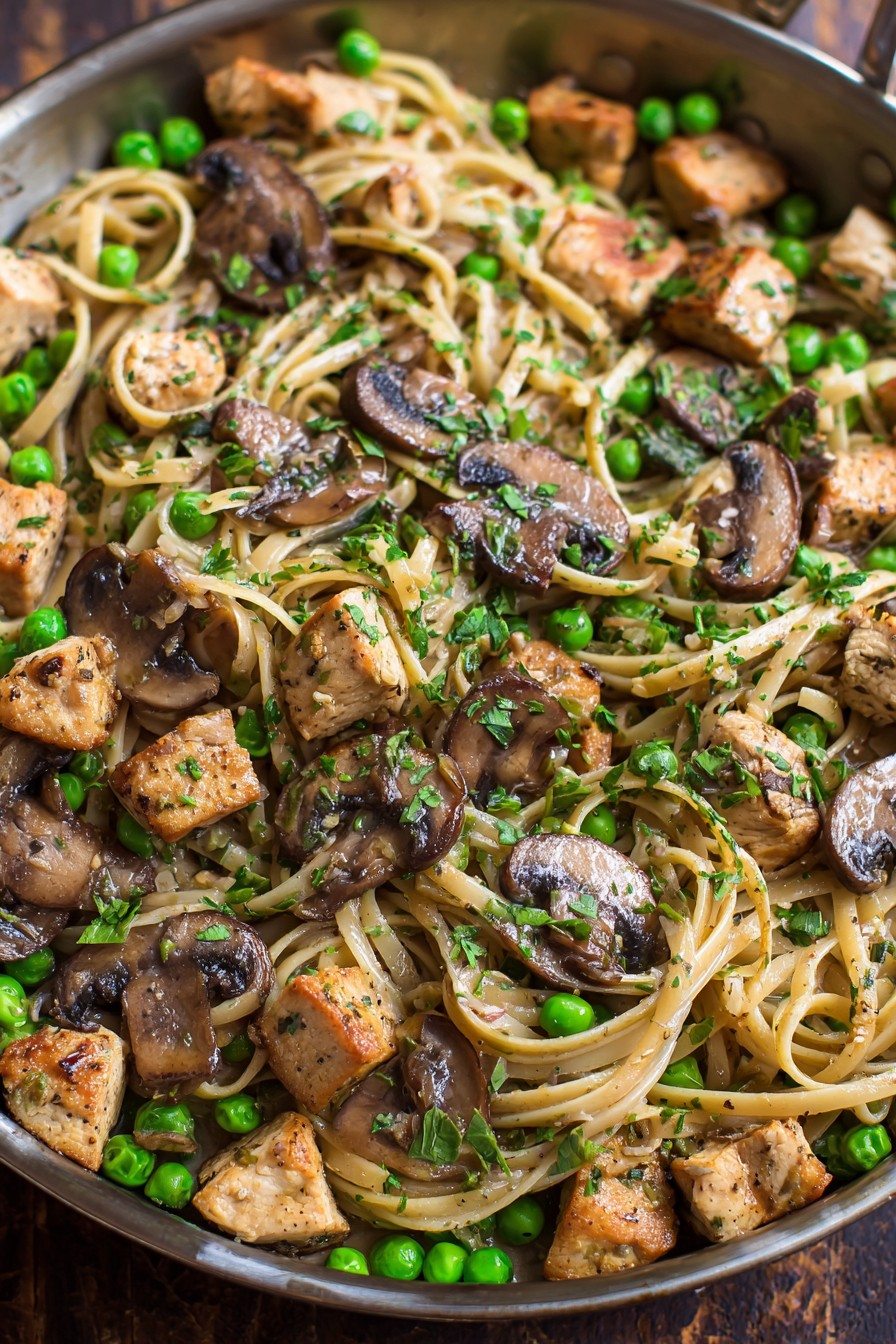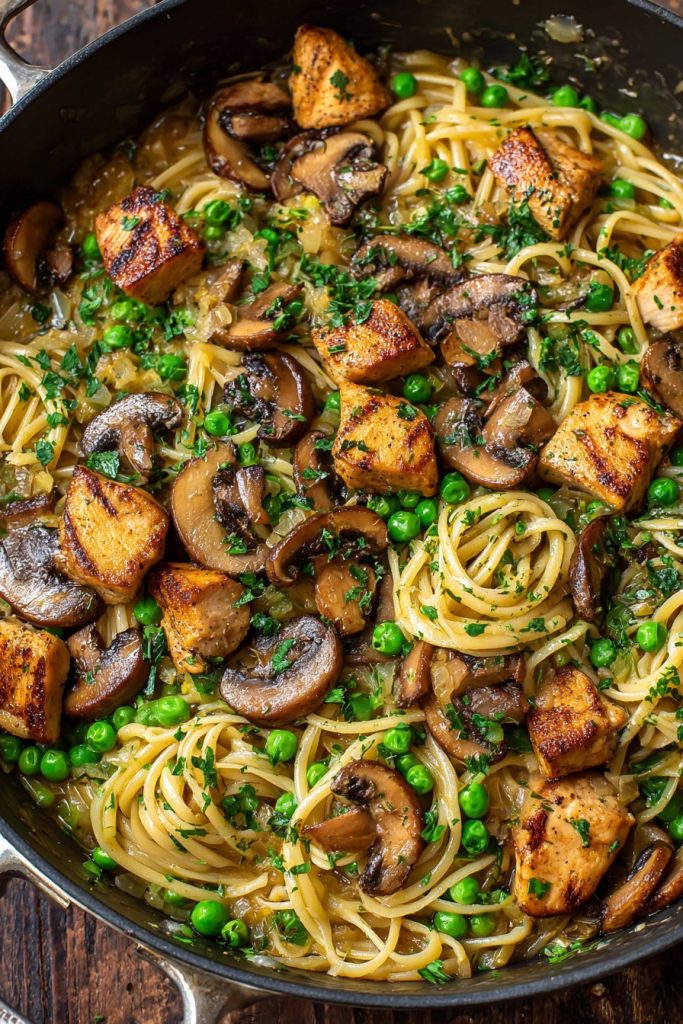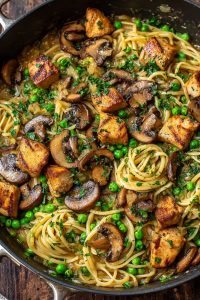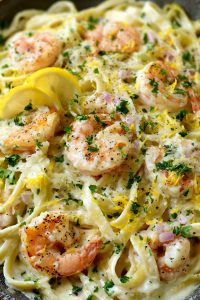Oh, the scent of garlic sizzling in olive oil still transports me back to my grandmother’s tiny kitchen, where she’d hum old Italian songs while stirring pots that seemed to hold all the comfort in the world. She never needed heavy cream to create magic—just good ingredients and generations of love passed down through stained recipe cards and flour-dusted aprons. This dairy-free version captures that same soul-warming essence, proving that the richest flavors come not from dairy, but from memories made around the table.
Why This Recipe Works
- The secret lies in creating a creamy sauce without a drop of dairy, using the natural starch from the pasta water combined with olive oil to emulsify into something luxuriously smooth that coats every strand and piece of chicken perfectly.
- Browning the chicken until it develops a golden crust creates fond in the pan that becomes the foundation for a deeply flavorful sauce, capturing all those caramelized bits that would otherwise be lost.
- Using fresh herbs rather than dried makes all the difference, releasing their essential oils slowly as they warm in the sauce, creating layers of flavor that dried herbs simply cannot replicate.
- The addition of nutritional yeast provides that subtle cheesy flavor dairy-free diets often miss, while also adding valuable nutrients that make this comfort food surprisingly wholesome.
- Resting the finished dish for five minutes before serving allows the sauce to thicken naturally and the flavors to marry, creating a harmony that reminds me of Sunday dinners when the whole family would gather.
Ingredients
- 1 pound boneless, skinless chicken breasts, cut into 1-inch cubes
- 12 ounces linguine pasta
- 3 tablespoons extra virgin olive oil, divided
- 1 large yellow onion, finely diced
- 4 cloves garlic, minced
- 8 ounces cremini mushrooms, sliced
- 1 cup frozen peas
- 1/4 cup nutritional yeast
- 1/4 cup fresh parsley, chopped
- 2 tablespoons fresh basil, chopped
- 1 teaspoon dried oregano
- 1/2 teaspoon red pepper flakes
- 4 cups chicken broth
- 1/2 cup dry white wine
- 1 lemon, juiced
- Salt and freshly ground black pepper to taste
Equipment Needed
- Large pot for boiling pasta
- Large skillet or Dutch oven
- Cutting board and sharp knife
- Measuring cups and spoons
- Wooden spoon or spatula
- Colander
- Mixing bowls
Instructions

Prepare the Chicken and Vegetables
Begin by patting your chicken cubes completely dry with paper towels—this crucial step ensures they’ll develop that beautiful golden crust rather than steaming in their own moisture. As you cube the chicken, remember how my grandmother would always say “even pieces cook evenly,” and she was right, as always. While working, heat 2 tablespoons of olive oil in your large skillet over medium-high heat until it shimmers, then season the chicken generously with salt and pepper. Cook the chicken in a single layer, resisting the urge to move it around too much, for about 4-5 minutes per side until deeply golden brown. Remove the chicken to a clean plate, and in that same glorious pan, add your diced onion, letting it soften and become translucent while scraping up all those beautiful browned bits from the chicken. Tip: Always pat chicken dry before cooking—this simple step makes the difference between steamed and properly seared meat.
Build the Flavor Foundation
Cook the Pasta and Create the Sauce
While your vegetables are working their magic, bring a large pot of generously salted water to a rolling boil—it should taste like the sea, as my Italian grandmother would insist. Add the linguine and cook according to package directions until al dente, usually about 9-10 minutes, reserving 1 1/2 cups of that precious starchy pasta water before draining. Meanwhile, pour the chicken broth into your skillet with the mushroom mixture, bringing it to a gentle simmer and letting it reduce slightly for about 5-7 minutes. Stir in the nutritional yeast until it dissolves completely, creating that subtle cheesy flavor that makes this dairy-free version so satisfying. Tip: Never rinse pasta after draining—the starch clinging to it helps the sauce adhere beautifully to every strand.
Combine and Emulsify
Return the browned chicken to the skillet along with any accumulated juices, then add the frozen peas straight from the freezer—they’ll heat through perfectly in the hot sauce. Add the drained linguine directly to the skillet, along with 1 cup of the reserved pasta water, using tongs to toss everything together vigorously. Watch as the starch from the pasta water combines with the olive oil and broth to create an emulsion that coats each strand in a velvety, creamy sauce without any dairy whatsoever. If the sauce seems too thick, add more pasta water a few tablespoons at a time until it reaches that perfect consistency that pools gently at the bottom of the bowl.
Finish and Rest Before Serving
Remove the skillet from heat and stir in the fresh parsley, basil, and lemon juice—these fresh elements added at the end provide brightness that cuts through the richness beautifully. Taste and adjust seasoning with more salt and pepper if needed, remembering that flavors continue to develop as the dish rests. Let the pasta sit for exactly 5 minutes off the heat—this resting period allows the sauce to thicken slightly and the flavors to marry in that magical way that only happens when you practice patience in the kitchen. Tip: Always let finished pasta dishes rest for 5 minutes—this allows the sauce to be fully absorbed and results in better texture throughout.
Tips and Tricks
If you find yourself without nutritional yeast, you can create a similar umami depth by using 2 tablespoons of white miso paste dissolved in a bit of warm broth before adding it to the sauce—this provides that savory quality that makes the dish feel complete. For those who prefer a thicker sauce, mix 1 tablespoon of cornstarch with 2 tablespoons of cold water and stir it into the simmering broth during the sauce-making stage, which will create a more substantial coating for the pasta. When cooking the chicken, make sure your skillet is properly preheated before adding the oil, then wait until the oil shimmers before adding the chicken—this initial high heat creates that perfect sear that locks in juices and creates wonderful flavor. If you’re preparing this dish for meal prep, undercook the pasta by about 2 minutes and store the components separately, then combine and reheat gently with a splash of additional broth to refresh the sauce. For an extra layer of flavor, consider roasting whole garlic cloves in their skins with a drizzle of olive oil at 400°F for 20 minutes until soft and caramelized, then squeeze the sweet paste into your sauce instead of using raw minced garlic. Always use a pot large enough for your pasta to move freely while cooking—crowded pasta releases too much starch and can become gummy rather than maintaining that perfect al dente texture. When adding the lemon juice at the end, start with half the amount called for, taste, then add more as needed since lemon intensity can vary greatly depending on the fruit’s ripeness and variety.
Recipe Variations
- For a vegetarian version that still delivers protein, replace the chicken with 2 cans of drained and rinsed chickpeas, roasting them with olive oil and spices at 425°F for 20 minutes until crispy before adding to the sauce—the creamy texture of chickpeas pairs wonderfully with the pasta and creates a satisfying meat-free alternative that even my carnivorous uncle enjoys.
- Transform this into a creamy tomato-based dish by adding 1 cup of crushed San Marzano tomatoes along with the chicken broth, then simmering for an additional 5 minutes to allow the flavors to meld—this variation always reminds me of the simple pasta dishes my mother would make on busy weeknights when time was short but comfort was needed.
- Create a richer, more decadent sauce by blending 1/2 cup of raw cashews soaked in hot water for 30 minutes until soft, then pureed with 1/2 cup of the pasta cooking water until completely smooth—this nut-based cream adds luxurious body and subtle sweetness that makes the dish feel truly indulgent while remaining completely dairy-free.
- For those who enjoy more vegetable-forward dishes, add 2 cups of fresh spinach during the last 2 minutes of cooking, allowing it to wilt gently into the sauce, along with 1 roasted red pepper cut into strips—the vibrant colors and varied textures make this version particularly appealing to children who might be hesitant about mushrooms.
- If you’re feeding a crowd or want leftovers for the week, this recipe doubles beautifully—just use a Dutch oven instead of a skillet to accommodate the larger volume, and increase the cooking time for the sauce by about 5 minutes to ensure proper reduction and flavor development.
Frequently Asked Questions
Can I use a different type of pasta for this recipe?
Absolutely, and I often do depending on what I have in my pantry or what mood strikes me. Fettuccine works wonderfully as its broad surface area catches the sauce beautifully, while penne or rigatoni are excellent choices because their hollow centers trap the sauce within each piece. The key is matching the pasta shape to the sauce consistency—thicker, creamier sauces like this one pair well with either long strands or short tubes that can hold the sauce effectively. Just remember to adjust cooking times according to the package directions since different shapes and brands can vary significantly in their optimal cooking duration.
What can I substitute for the white wine in this recipe?
How should I store and reheat leftovers?
Store any leftovers in an airtight container in the refrigerator for up to 4 days, though the pasta will continue to absorb the sauce over time. When reheating, I recommend using a skillet with a splash of additional broth or water over medium-low heat, stirring gently until warmed through—this method helps refresh the sauce without making the pasta mushy. Avoid microwaving if possible, as it tends to overcook the pasta and can create an uneven texture, though if you must use a microwave, cover the dish and heat at 50% power in 1-minute intervals, stirring between each interval.
Can I make this recipe gluten-free?
Yes, and it works beautifully with a few simple adjustments. Substitute the regular linguine with your favorite gluten-free pasta—I’ve found that brown rice pasta or chickpea pasta both hold up well in this type of sauce. Be sure to check that your chicken broth is certified gluten-free, as some brands contain hidden gluten, and consider using tamari instead of soy sauce if you add any additional seasonings. When cooking gluten-free pasta, be extra careful not to overcook it, as these varieties can become mushy more quickly than traditional wheat pasta, and you may need slightly less pasta water for the sauce since gluten-free pasta often releases more starch.
Why is my sauce not thickening properly?
If your sauce isn’t reaching that lovely creamy consistency, there are several troubleshooting steps you can take. First, ensure you’re using enough starchy pasta water—sometimes it takes the full 1 1/2 cups or even a bit more depending on the pasta brand. The vigorous tossing action is crucial for emulsification, so don’t be shy about really working the pasta and sauce together. If after several minutes of tossing it’s still too thin, create a quick slurry by mixing 1 teaspoon of cornstarch with 2 tablespoons of cold water and stirring it into the simmering sauce off the heat. Remember that the sauce will continue to thicken as it rests, so patience often solves the problem naturally.
Summary
This dairy-free chicken pasta captures the essence of family comfort food through clever techniques that create creaminess without dairy, proving that the most memorable meals come not from complicated ingredients but from love and tradition passed down through generations.



